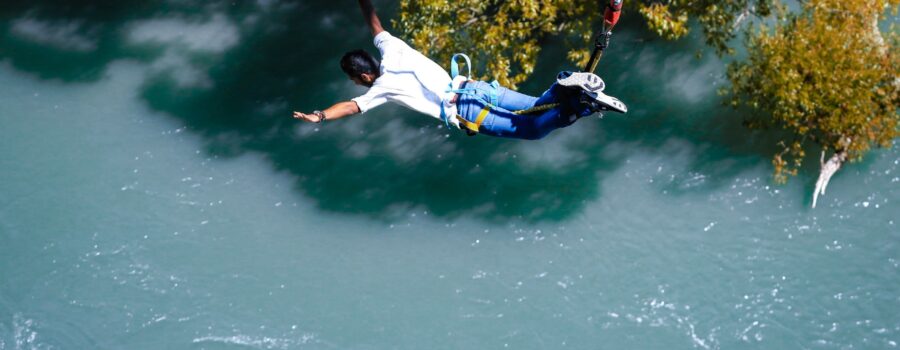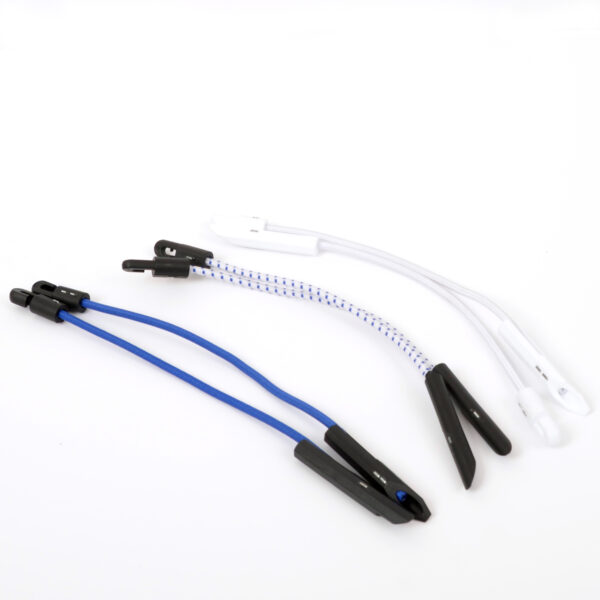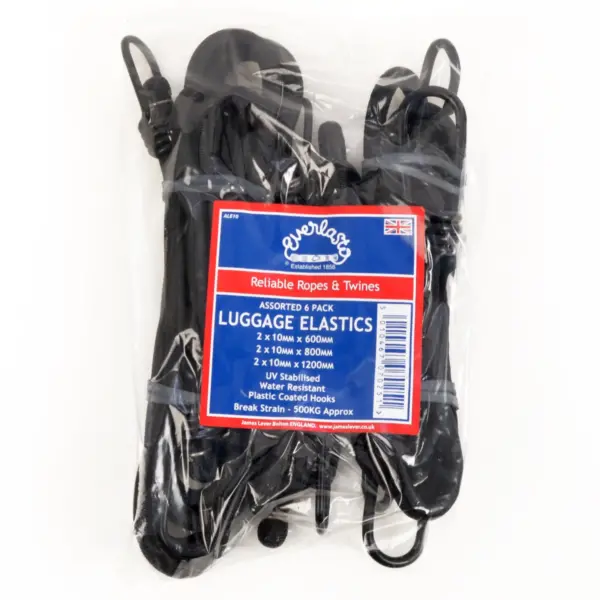We couldn’t be a bungee cord company with a blog and not cover bungee cord jumping! Whilst our bungee cords are more for work or domestic use – whether it’s a bungee cord chair or a bungee cord catapult – we can appreciate the bungee cords used for bungee jumping and thought we would cover a safe guide for this adrenaline-chasing activity.
So welcome, adventure seekers. If you’re looking to get your adrenaline pumping, then bungee jumping is a sport like no other that’s bound to do the trick. In this guide, we’ll discuss what bungee jumping is, the science behind bungee jumping, how it works, how to bungee jump safely and the best spots to bungee jump in the world.
What is bungee jumping?
Bungee jumping is classed as an extreme sport that involves jumping off tall structures such as bridges and pedestals whilst tied with long elastic bungee cord. The rope stretches and contracts during freefall, so you can experience the thrill of falling without the risk of hitting the ground. This is an activity that combines excitement, adventure and a dash of bravery to create an unforgettable experience.
Of course, bungee jumping doesn’t come without its risks. But before we dive into the nitty gritty, it’s worth understanding the science behind bungee jumping.
The science behind the bungee jump
First, let’s examine the science behind the bungee jump, the physics, if you will, because it’s pretty cool! The science behind bungee jumping is quite simple, in theory. Bungee cord is the component that safely ties the jumper and both stretches and recoils upon descent from a great height. Bungee cords are made from strong materials such as latex and/or elasticated rubber core.
For this extreme sport, the bungee cord – aka braided shock cord – used needs to be exceptionally thick and sturdy enough to hold a good amount of weight as it springs back. Typically, the minimum weight for bungee jumping is 35/40kg with the maximum weight being around 145/150kg.
Understanding the physics of the bungee jump is to understand the three stages to it and the forces at play.
1. The free fall
When the jumper leaves the starting point, the cord is relaxed because of the free fall with gravity pulling them down. Because there is only one constant force acting on the jumper at this stage, there is a constant acceleration towards the ground below, and the acceleration rate is 9.8m/s2 (the acceleration of gravity).
2. The stretching
After the jumper reaches the full vertical position and gets to a distance from the attachment point that is equal to the length of the bungee cord, the stretching of the cord begins. When this happens, gravity isn’t the only force acting on the jumper. The stretch of the cord creates tension, an upward force that is opposite to gravity. This tension force increases as the cord stretches and will eventually become greater than the force of gravity. This causes a switch in direction, with acceleration going upwards.
3. The recoil
This is when the cord begins to spring back due to reaching its full stretching potential. When the cord is recoiling, the tension decreases, meaning that the upwards acceleration is not constant. The tension will decrease so much so that the force of gravity will become greater, once again. When this happens, the jumper will repeat the full process, going back to free fall, eventually slowing down because of air resistance.
Who can do bungee jumping?
The general maximum weight for bungee jumping is 145/150kg. So if you’re under this weight capacity, have no injuries or medical complications, are in good health, aren’t pregnant, and are feeling brave, then anyone can go for it. It’s an inclusive, accessible sport that can be tried by amputees and people with partial paralysis or reduced mobility.
If you suffer from epilepsy, heart disease, joint problems or have a high level of anxiety, then you may not be allowed to participate. It’s always best to check with the bungee site in advance. It’s also best to bungee jump on an empty stomach, and you shouldn’t be under the influence of any drugs or alcohol.
How to bungee jump
You’re not just taking a leap when you bungee jump. There’s a lot of prep, knowledge and safety precautions to go through beforehand. Here’s everything you need to know before, during and after your bungee jump so you’re safe and sound throughout.
1. Choose a reputable bungee jumping operator
This is especially important. Check the safety standards they stick to, read their Trustpilot reviews, certificates and ask as many questions before making the decision to bungee jump with a specific provider.
2. Get a health check
As you can probably imagine, bungee jumping, or any extreme sport for that matter, can affect those with pre-existing conditions, particularly those revolving around the heart. Always consult your doctor before bungee jumping for a full check-up. It goes without saying that pregnant women or those with existing injuries cannot bungee jump.
Typically, if any of the following apply to your health circumstances, you must seek professional medical advice before jumping and will have to sign a non-standard waiver;
- High blood pressure
- Heart condition
- Dizziness or epilepsy
- Neck, back, spinal column, legs or eye injuries
- Asthma
- Declare any medication you may be taking.
3. Get inducted
You’ll receive a briefing or induction before you bungee jump. They’ll explain everything you need to know, demonstrate how to bungee jump, explain dos and don’ts, address any worries and concerns, plus any other questions you have.
4. Wear the right gear
Ideally, you should wear comfortable clothing that provides you with room to move, but do not wear anything loose and tie back any long hair so it doesn’t get caught on the bungee cord. Typically, your bungee jumping provider will provide you with a harness, ankle attachments and other safety equipment you may need – but just ensure it’s fitted correctly by the staff on hand.
5. Prepare yourself for the jump
Now that you’re geared (and clued) up for your bungee jump, you’ll now be prepared to take the leap. Be sure to listen to your instructor’s guidance closely and follow all of the instructions. Do a few breathing exercises to keep you cool and grounded, then embrace the adrenaline rush that’s to come!
Safety tips for bungee jumping
1. Plan in advance
Contact the bungee site to check all the requirements and view the website for information and any certification. Read reviews and do your research to check it’s a safe, reputable company.
2. Bring suitable clothing
Dresses, skirts, and heels are a no-go. Make sure nothing’s going to get in your way or cover your face. Trainers or boots are a good idea. Flip-flops or slip-ons? Not so much.
3. Attachment safety
There are two ways to attach to a bungee cord, by the ankles and a harness. Harnesses are worn around the waist, thighs, chest and shoulders, with the cord connected at the front to both the pieces of harness. The bungee site will check over things, and they should make sure everything is tight enough and secure.
4. Arrive early and prepare
Typically, bungee sites will want you to arrive at least an hour before your slot to get prepared and go through the safety briefing. You’ll also be weighed so that you will be set up with the right rope. You should relax as much as possible, which may be hard to do, you’re only human! But, rushing around, stressed and not giving yourself enough time to prepare is not a good idea. You need to be present and highly aware of your surroundings, listening attentively to the professionals. It’s also a good idea to watch a few jumpers before it’s your turn, or even watch videos online to help with your preparation.
5. Be in good health and sober
It can’t be reiterated enough how important it is to check you’re in a healthy condition for a bungee jump. As mentioned, if you suffer from heart disease, epilepsy, joint problems, or a certain medical condition, you may not be able to do this activity. And you certainly shouldn’t be under the influence of drugs or alcohol.
6. Know your limits
Bungee jumping isn’t for the faint-hearted. It can be physically and mentally demanding, so you’ll need to assess your own physical and mental health, and even seek medical advice if you’re unsure. Nerves are completely normal before the jump, but if they’re crippling you, there’s no shame in postponing your bungee jump to a time when you’ll feel more prepared.
If bungee jumping just isn’t right, why not try bungee running instead? In fact, there’s a plethora of bungee fitness activities you can do instead, which make for a great HIIT workout and get the heart pumping too!
7. Post-bungee jump
Make sure to listen carefully to the instructors once you’ve ticked the jump off your bucket list! You’ll be full of an adrenaline rush, so make sure you pay attention and are in a safe place when having your gear detached from the rope and harness taken off.
If you are brave enough and thinking about doing bungee jumping, just remember to bookmark this, and don’t forget to have someone behind the camera to capture your adventure! And why not browse The Bungee Store to see all our colourful bungee cords. You could even create a little bungee jump experiment with the kids’ toys at home to see how it works!
Where are the best spots for bungee jumping in the world?
There are many places to bungee jump in the world, here are our top recommendations for places to bungee jump all around the world:
- Europabrucke Bridge (Austria)
- Battersea Park south of the river (London)
- Altopiano di Asiago (Italy)
- Lloret de Mar (Costa Brava)
- Kaivopuisto, Helsinki (Finland)
- Nevis Highwire in Queenstown (New Zealand)
- Victoria Falls Bridge (Zambia)
- Macau Tower in Macau (China)
- Bloukrans Bridge in Western Cape (South Africa)
- Verzasca Dam in Ticino (Switzerland)
Is bungee jumping safe?
Bungee jumping is a fun, thrilling and exhilarating experience for adrenaline seekers. But like with any extreme sport, it doesn’t come without its risks.
Inspired to bungee jump? Contact our team of experts who can help you source the best bungee cords in the business. Plus, our team have experience with bungee jumping firsthand and will be able to answer any questions you may have.

 5mm x 300mm Elastic Bungee Toggle Ties
From: £2.99
5mm x 300mm Elastic Bungee Toggle Ties
From: £2.99
 Steel Hog Rings (100 pack)
From: £12.19
Steel Hog Rings (100 pack)
From: £12.19
 Polypropylene Cargo Rope 10mm
From: £3.28
Polypropylene Cargo Rope 10mm
From: £3.28
 6 Pack - Assorted10mm Luggage Elastics
From: £5.36
6 Pack - Assorted10mm Luggage Elastics
From: £5.36
 Polypropylene Cargo Rope 6mm
From: £1.81
Polypropylene Cargo Rope 6mm
From: £1.81
 Polypropylene Cargo Rope 12mm
From: £3.82
Polypropylene Cargo Rope 12mm
From: £3.82
 Lastoflex Bungee Cord 8mm
From: £10.32
Lastoflex Bungee Cord 8mm
From: £10.32
 Lastoflex Bungee Cord 10mm
From: £11.46
Lastoflex Bungee Cord 10mm
From: £11.46
 Lastoflex 6mm Bungee Cord
From: £4.67
Lastoflex 6mm Bungee Cord
From: £4.67



